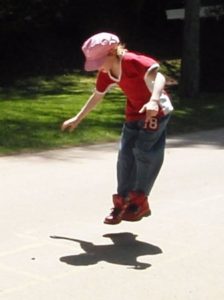 Why I Picked It Up:
Why I Picked It Up:
This book just came to us – quite literally! It’s a brand new book, written by Children’s Choice Award Nominee Sudipta Bardhan-Quallen, published on April 4th, and we were contacted by the publisher who sent us a copy of the book in exchange for our honest review. (We also get to give away a copy! Read to the end for the giveaway details!) This was one of two that we received, but because this one had a platypus looking horrified as he’s falling from a tree on the front, it was naturally a “Jessica” book.
Why I Finished It:
It’s plain fun! The quick moving and rhyming story keeps Splatypus moving among different groups of animals, trying to fit in. He’s trying to find his place and a group of friends he can keep up with. He moves from trying to play in a tree with the possums, jumping with kangaroos, and running with dingoes. After realizing that he was more than likely going to hurt himself trying to fit in, he finds his niche with the penguins and water animals. Children’s book enthusiasts will also recognize the illustration style of Jackie Urbanovic, The New York Times bestselling creator of Duck books.
Who I Would Give It To:
This will be a hit in every primary classroom. The animals are unique, the story is catchy, and the words on the page move with the action. When Splatypus falls from the tree, the words on the page fall with him. As you read the story out loud you begin to move with poor Splatypus! Teachers will love the book because of the message it delivers: you should always be yourself and try new things.
Integration Ideas:
Rhyming
Read the story one time through just for fun. Then ask the students if they heard any rhyming words. A few might remember, but many students wouldn’t be too sure. Read it again, and this time, have the students put a thumb up (or some kind of gesture) when they hear words that rhyme. Then, ask the students again which words rhymed in the story. Write (or already have written) the rhyming words on index cards. Hand each card out to a student. Read the story one more time, this time have the student who has that card raise it when they hear their word. Put the words in a rhyming station so students will continue to be exposed to those words.
Ask the students why the author chose to rhyme some words on the page. There isn’t a right or wrong, so students will have the opportunity to share what they think. Responses might include: for the sound of the story, that it makes the story flow, it’s pleasing on the ears (to read aloud), or other reasons.
Social Studies and Science
I naturally gravitated to this book, but I’ve also spent months in Australia (one of my favorite countries). Many of our students here in America would not be knowledgeable about some of these animals. I would frontload the students with information about Australian animals and have them share how those animals move and what type of climate they live in. I would give age appropriate information to the groups of students, meaning it would be short and there would be lots of pictures. Students would then have to draw a picture and explain how the animal moves and where it lives to the rest of the class. Then when they read the story, they would have more context for, and be better able to relate to the animal.
Definitely show the students where Australia is and how it is a continent, country, and island. The students love to learn a little bit about other places.
Combine the two and “take” the students to the Australian zoo! Here is the link to the dingo exhibit: https://www.australiazoo.com.au/our-animals/mammals/dingoes. Not only can they learn information about the animals, they can see the specific animals in the zoo there.
Verbs
I love using animals to teach students action verbs. Reread the book and stop after every page, having the students repeat how the animal is moving. For example the dingoes “chase”. Have the students act this out. Go through the book and have the students pull out the action verbs and act them out; bound, leap, jump, skip, etc. This would be fun to do outside on a nice day.
Follow this up by giving the students a picture of an animal that they researched earlier and ask the students to act out how they move. Then, as a class, develop a list of verbs that tell how the animal moves.
Giveaway!
Would you like a copy of this fun new book?? Of course you do! To enter in the drawing to be our lucky winner, just comment on this post with why you think your students might enjoy this book or what you would use it for in your classroom. We will randomly draw from all commenters on April 20, 2017 and the winner will be contacted via email so we can get your copy of Splatypus to you!






Sounds like a good book for: Moral of the story
I would love to use this for the cross curricular connections! So much fun!
I teach an Australian class in a summer school program for elementary students. This would be a perfect book for introducing Australian animals.